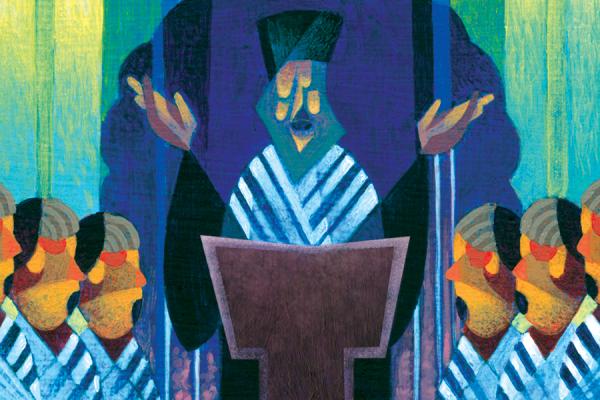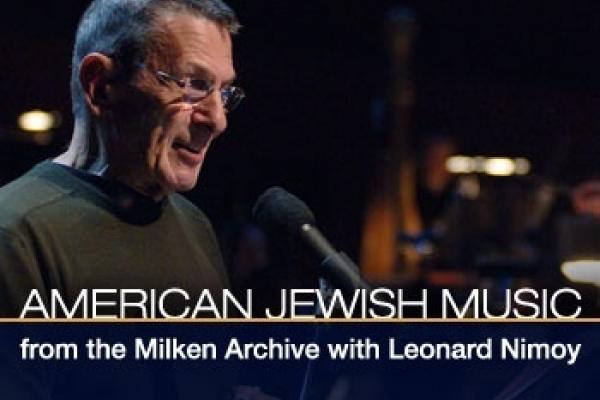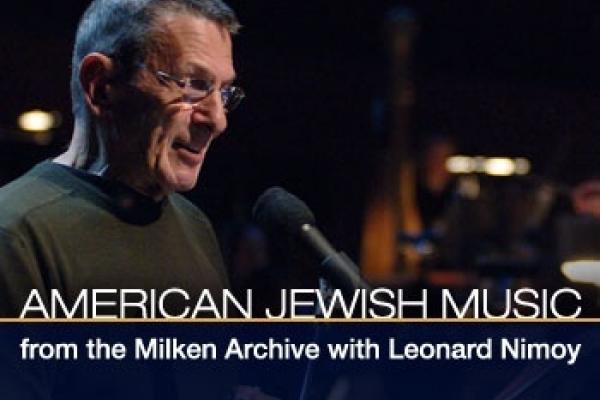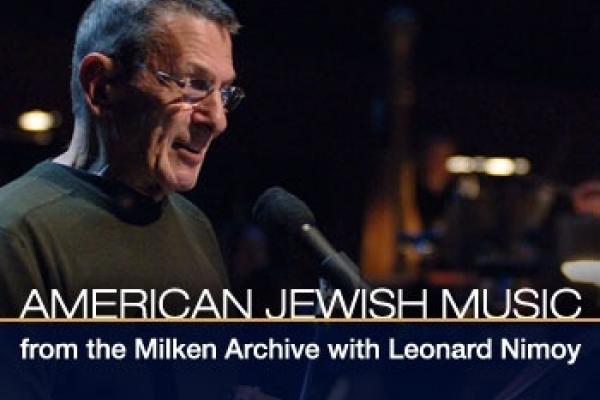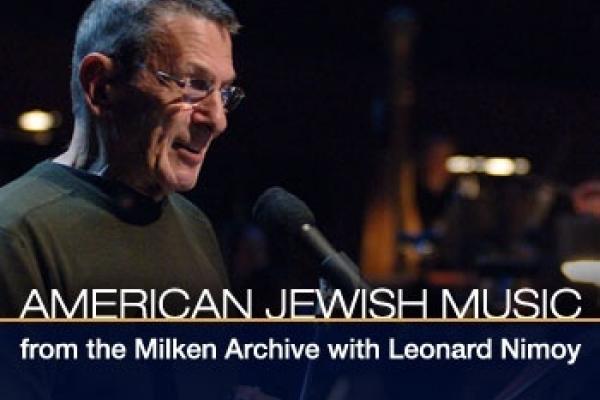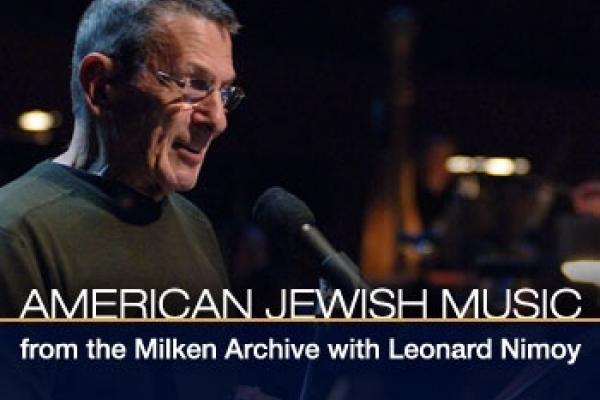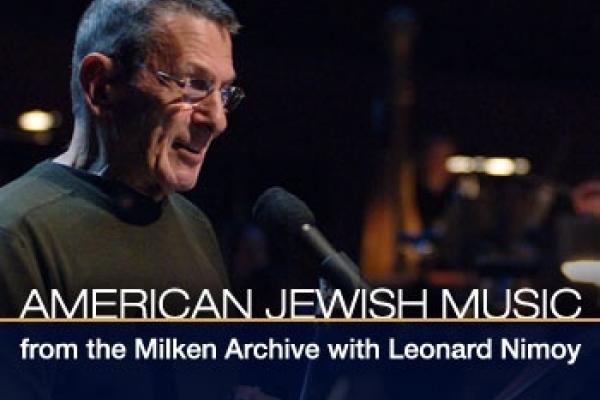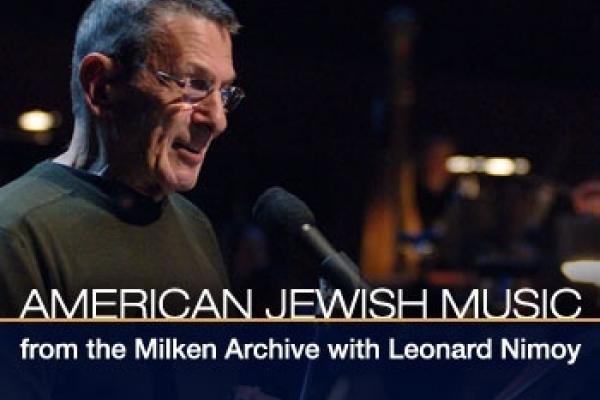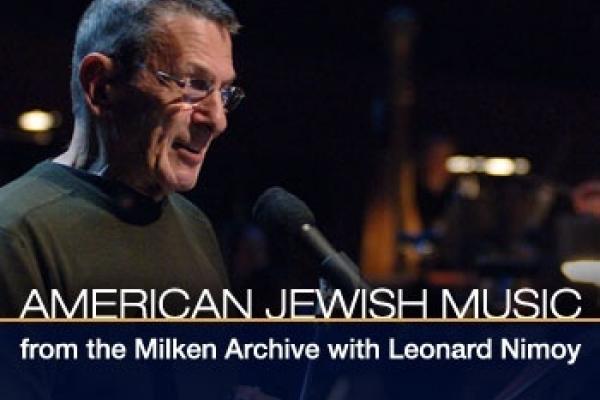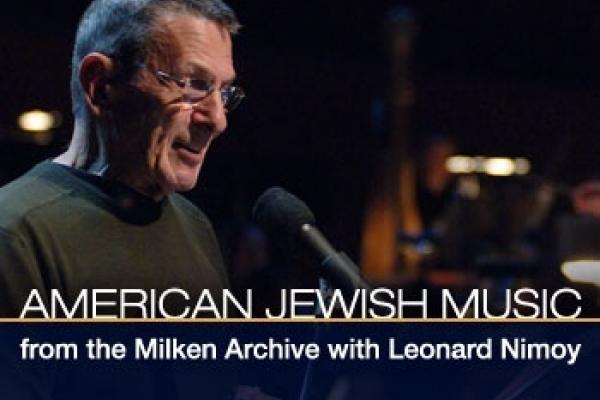Episode 12: Klezmer
Click on the ![]() icon on the top-right of the video to access the full playlist.
icon on the top-right of the video to access the full playlist.
Particularly after their revival in folk and popular music, the unique inflections of klezmer music have influenced concert works as well. This episode features klezmer-inspired works and includes performances by virtuoso clarinetist David Krakauer.
Episode Transcript
Leonard Nimoy
Classical music draws from two great spheres of human experience: the sacred and the secular. The sacred realm inspires works of meditation and exaltation, petition and praise. Music for secular occasions celebrates life and love through singing and dancing. And there’s no occasion for celebrating quite like a wedding.
Leonard Nimoy
Hello, I’m Leonard Nimoy. Welcome to another program in a 13-part series that celebrates three and a half centuries of uninterrupted Jewish life in the United States through music, as documented by the Milken Archive of American Jewish Music, and issued on CD on the Naxos label. On today’s program: classical works inspired by the uniquely Jewish wedding music called “klezmer.”
Leonard Nimoy
In a conversation recorded for this program, Gerard Schwarz – Music Director of the Seattle Symphony and a member of the Milken Archive’s editorial board – asked Neil Levin, Artistic Director of the Milken Archive, about the history of klezmer music.
Gerard Schwarz
Some of the most popular music that we all think of as being Jewish music is Klezmer music. We think of the Klezmer bands. We think of a clarinet player playing with a very shrill, bright tone. And we think of people people dancing and having a wonderful time at a wedding. Neil, what is klezmer, and where does it come from?
Neil Levin
Klezmer means instrumental musician. That's all. What we loosely call a "klezmer" band. It's a very recent way of wording it. Klezmorim, the plural of klezmer, has a historical place in terms of usage. In the Middle Ages, bands started to form in Western Europe in the roots of Ashkenazi Jewry, and then later spread to Eastern Europe, and they were called klezmorim. Their primary function was to play at wedding parties and celebrations, but also at other similar joyous celebratory occasions. What we associate today with so-called klezmer music sound, that is music of the klezmorim, is 19th century Eastern European klezmorim sound. Certain idioms, certain inflections that come right out of Gypsy music in many cases, out of cantorial sounds. It's important to remember that klezmorim played as background music, not music to listen to for spiritual refreshment, for probing analysis, for concert environments, not at all. Background music, to dance to, to talk against, everything.
Leonard Nimoy
Klezmer has inspired a number of works for the concert hall. One of the most successful is a piece commissioned by the flutist Carol Wincenc by Paul Schoenfield called “Klezmer Rondos.”
Gerard Schwarz
Paul Schoenfield's Klezmer Rondos is a piece that embraces many different aspects of 20th century, 21st century music, and these wedding bands. It has a combination of a wedding band, the solo flute and the solo tenor, and a symphony orchestra. So it is a concerto in a traditional sense. It is a concerto grosso for a wedding band and orchestra. It's an opportunity for a cantor to sing in the middle of this wedding ceremony in a way. And yet he brings this all together in a remarkably fluent way. He integrates the music so that it sounds like an extraordinary masterpiece of technical brilliance that he was able to bring this all together and take these desperate elements and make them sound like one great work.
Neil Levin
Schoenfield is extraordinary. He starts off with what is a folk element, the typical sounds of klezmorim, whether it was in Europe in the 19th century, early 20th century, whether it was in America, in large cities of Eastern European immigrants in the early 20th century or so forth. But he starts off with that as a folk element, but he creates a completely artistic, classically orientated piece out of it.
Leonard Nimoy
Neil Levin and Gerard Schwarz. Here is Paul Schoenfield’s “Klezmer Rondos” in a performance by flutist Scott Goff, and cantor Alberto Mizrahi, with the Seattle Symphony Orchestra conducted by Gerard Schwarz.
Paul Schoenfield's Klezmer Rondos
Leonard Nimoy
Gerard Schwarz conducted the Seattle Symphony, with flute soloist Scott Goff and cantor Alberto Mizrahi, in a Naxos release of Paul Schoenfield’s “Klezmer Rondos.”
Leonard Nimoy
You’re listening to a program from the Milken Archive of American Jewish Music Music; I’m Leonard Nimoy. Conductor Gerard Schwarz and musicologist Neil Levin are back with us to introduce the next eastern European klezmer-inspired piece on our program, by the composer Robert Starer.
Gerard Schwarz
Well, we move from the flute being the primary instrument in our klezmer show to the clarinet being the most prominent instrument in Robert Starer's concerto, a remarkable piece by a remarkable composer, a composer who wrote some exquisite music and really found his Jewish roots later in his life and was very attached to his upbringing, his background, his heritage. And he wrote this exquisite clarinet concerto.
Neil Levin
Starer, of course, comes from a background in where this kind of sound really was not part of his community or his city or family tradition or anything of that nature. So it's, again, something to which he was exposed in America. It's this mix of cultures, this openness on the American scene that was never quite present to this extent anywhere else. Being in New York alone, it was pretty hard then, as it is now, for cultures not to mix and traditions not to mix and one not to hear Cantorial sounds or a klezmer band sounds or Yiddish language sounds and so forth, even if one isn't Jewish because it's in the air. The atmosphere is one of great sharing. The clarinet became even more prominent in wedding bands among the klezmorim in the early part of the century. And I think part of that was due to certain virtuoso clarinetists who emphasize the role of solo clarinet and its idioms and its clichés, certain whaling sounds, certain size that they were able to create clarinets such as Naftule Brandwein and Dave Tarras. And Starer relied heavily on that very correct perception of the clarinet as, in a way, the kind of cantor.
Leonard Nimoy
Here is a performance by one of the best-known clarinetists for this virtuoso eastern European klezmer style, David Krakauer, with the Barcelona Symphony/National Orchestra of Catalonia under the direction of Gerard Schwarz. This work by Robert Starer has 4 movements: “Prayers,” “Dances,” “Melodies,” and “Dedications.” Its title is derived from the biblical Hebrew expression thought to designate “musical instrument” -- “Kli Zemer.”
Leonard Nimoy
Robert Starer’s work for klezmer-band style clarinet and orchestra entitled “Kli Zemer” – the biblical Hebrew reference for “musical instrument.” The soloist was clarinetist David Krakauer, with the Barcelona Symphony/National Orchestra of Catalonia conducted by Gerard Schwarz, from a Naxos release.
Leonard Nimoy
We’ll be hearing more from David Krakauer in few moments. This two-hour program, part of a series from the Milken Archive of American Jewish Music, is devoted to concert works inspired by the festive Eastern European instrumental music of Jewish bands for weddings and other joyous celebrations, now often called “klezmer.” I’m Leonard Nimoy.
Leonard Nimoy
Welcome back to this program from the Milken Archive of American Jewish Music. I’m Leonard Nimoy. Today we’re listening to compositions that respond to the rhythms and sonorities of the music typically played by 19th-century eastern European Jewish wedding band musicians, the “Klezmorim” — the plural of klezmer.
Leonard Nimoy
Lowell Milken, who founded the Milken Archive in 1990, talked in a recent interview about Jewish music as a part of American history.
Lowell Milken
I've always been a believer that everyone is interested in learning more about their roots. The question is, at what time in their life are they interested in doing that? But in any event, what we've created here spans 350 years of history. It's part of American culture with all of its diversity. And it not only enables us to learn a great deal more about the time period and the influences that impacted that time period of our parents and our grandparents, but really of generations that really go far back before then. So we think it's a wonderful opportunity for people to explore really almost four centuries of history in America.
Leonard Nimoy
The founder of the Milken Archive, Lowell Milken. The composer Ofer Ben-Amóts was born in Haifa in 1955 and came to the United States in 1987. He currently is associate professor of music at Colorado College in Colorado Springs. Conductor Gerard Schwarz and Neil Levin, Artistic Director of the Milken Archive, had this to say in a recent conversation about Ofer Ben-Amóts’ work “Celestial Dialogues.”
Gerard Schwarz
Ofer Ben-Amots's Celestial Dialogues, again, looks towards older forms, dance forms, more popular forms.
Neil Levin
Ofer Ben-Amots's is a master at utilizing not only folk, but even liturgical elements, and creating a completely original artistic statement out of those. In the Celestial Dialogues, we have several different elements. I mean, there is the religious element, the kind of reenactment of the tradition in Israel, but in particular in Jerusalem, of the functionary from the little synagogue knocking on every door one by one, saying, get up, it's time for prayers.
Gerard Schwarz
Can you speak specifically about each of these movements? Of course, Freylekh is something we all think about and know about, but there are three specific movements with three specific ideas.
Neil Levin
The Freylekh, which is the second movement here, and he calls it "A Celestial Freylekh." But a Freylekh simply means a light-hearted, almost comparable to the German Gemütlich. A Freylekh means joyous and merry. And it's also, therefore, the name of one of the typical dances that klezmorim would play at Jewish weddings in Eastern Europe and in America of Eastern European tradition. And he calls it Celestial Freylekh because it's also the the whole universe is rejoicing. The first movement is called "A gasn nign." Now a nign, it simply means a tune. A gasn nign, gasn is a little street, a back alley. And a gasn nign means the type of melody that a wedding band might have been playing out in the street as the guests arrive for the wedding. And then the third movement refers to that call to prayer, that call to worship at dawn or just before dawn. It's a very mysterious kind of atmosphere attached to it.
Leonard Nimoy
Here again is David Krakauer, clarinet, with Cantor Alberto Mizrahi and the Barcelona Symphony/National Orchestra of Catalonia under Karl-Anton Rickenbacker in three movements from “Celestial Dialogues,” by Ofer Ben-Amóts.
Ofer Ben-Amots's Celestial Dialogues
Leonard Nimoy
Karl-Anton Rickenbacher led that performance by the Barcelona Symphony/National Orchestra of Catalonia, in excerpts from a Naxos release of “Celestial Dialogues” by Ofer Ben-Amóts. The soloists were Cantor Alberto Mizrahi, and clarinetist David Krakauer.
Leonard Nimoy
Next, David Krakauer will play two short pieces by Jacob Weinberg inspired by 19th-century klezmer sounds, in arrangements made around 1940 for clarinet and orchestra by Simeon Bellison. Gerard Schwarz talks about Bellison with music historian and musicologist Neil Levin.
Gerard Schwarz
Bellison was a Russian emigré who became one of the great clarinetists of the first half of the 20th century, and in fact, became Principal Clariate of the New York Philharmonic, and had tremendous influence on music of this type because he played it. He played it regularly, and he continued to play in wedding bands, even when he was in the New York Philharmonic.
Neil Levin
Simeon Bellison is an extraordinary figure, crossing various lines in aspects of Jewish music history. He founded or was part of a group called the Zimro Ensemble, whose mission it was to propagate the musical ideas and the music itself of the St. Petersburg Society for Jewish Folk Music. Bellison and this group, the Zimro Ensemble, went on tour all around the world to play both classical music together with music of Achron and Nielsen and Milner and so and forth, who had been active in the Society for Jewish Folk Music. And their mission was to go to Palestine and set up a temple for Jewish art there based upon money they had raised from all these concerts. Well, Bellison, when he got to New York, was offered the position at the Philharmonic shortly afterwards. And so he never went to Palestine. He stayed in New York. He did go to Palestine when he retired, and the Bellison Archive is in Jerusalem now. But he either commissioned or was instrumental in the creation by others of a lot of clarinet music along these lines with these kinds of sounds, but artistically written for solo clarinet and orchestra. And the pieces that we recorded, too, by Jacob Weinberg, we wouldn't even know about those pieces if it weren't for the Simeon Bellison archive.
Gerard Schwarz
What's interesting about the performance of those pieces, too, is David Krakauer, the soloist, puts on a special mouthpiece to create a very bright, shrill tone that he believes is the authentic sound that the music should be played with. And it's very different from the traditional clarinet tone that we're used to in the United States. And at the same time, it feels very correct and idiosyncratic.
Neil Levin
To play those things classically wouldn't work. I mean, it would be the same thing in cantorial music. You could not expect the greatest tenor in the world, whoever that might be, to take a cantorial recitative, even if you could write down the improvisatory notes and have him know what to do with it. It would not be possible because it's something that's learned from experience.
Gerard Schwarz
You'll also notice some bending of the notes, some glissandos that he uses, and of course, a different vibrato that is not often used on the clarinet.
Neil Levin
Those are all idioms and clichés of the klezmorim in Europe, the instrumental folk music.
Leonard Nimoy
Here again is David Krakauer to play “The Maypole” and Canzonetta” by Jacob Weinberg. Gerard Schwarz conducts the Berlin Radio Symphony Orchestra.
Jacob Weinberg's Canzonetta and The Maypole
Leonard Nimoy
Two pieces by Jacob Weinberg – “The Maypole” and “Canzonetta” – arranged for orchestra by Simeon Bellison, and played by David Krakauer with the Berlin Radio Symphony Orchestra conducted by Gerard Schwarz…a Milken Archive recording on the Naxos label.
Leonard Nimoy
This program of music inspired by 19th-century klezmer sounds will conclude with incidental music for a play, based on a story by Isaac Bashevis Singer. Gerard Schwarz asked Neil Levin about the composer of this score.
Gerard Schwarz
Yehudi Wyner wrote some wonderful music inspired by literature. What do you think Yehudi Wyner's relationship to Yiddish literature or even more popular musical forms is?
Neil Levin
Well, Yehudi Wyner was never really interested in the more popular forms. I think he would second that. His upbringing in terms of Yiddish literature concerns the "hoch" literature, the high literature, the most sophisticated, whether it be prose or poetry, because his father, Lazar Weiner, was the supreme avatar of Yiddish art song on the highest level, and Yiddish cantatas and other musical settings of the most profound levels of Yiddish poetry. Yehudi, in many ways, is a more general composer. Not all of his works are Judaically related, whereas virtually all of his father's works are Judaic in substance. He is, first and foremost, an American composer who is heavily rooted in Jewish tradition in many ways. His interest, therefore, in writing incidental music to a play by Isaac Bashevis Singer is understandable. What Yehudi does is essentially compose freely and then occasionally bring in musical substance of folk tradition, but in a very sophisticated way. And it's usually there for a moment or two, and then he leaves it. He's not an arranger of folk music. He's an original American composer. And even when he brings those elements in, they're brought in in a very subtle way.
Leonard Nimoy
Here is that music, played by Richard Stoltzman, clarinetist, Daniel Stepner, violinist, and Robert Schulz, percussionist. The singers are Carol Meyer, soprano; Judi Brown Kirchner, mezzo-soprano; Matthew Kirchner, tenor; Richard Lalli, baritone; and James Guttmann, doublebass. This is incidental music by Yehudi Wyner for the play “The Mirror,” adapted from a story by Isaac Bashevis Singer.
Leonard Nimoy
Incidental music for a play called “The Mirror,” after Isaac Bashevis Singer. The music was composed by Yehudi Wyner, and sung here by Carol Meyer, soprano; Judi Brown Kirchner, mezzo-soprano; Matthew Kirchner, tenor; Richard Lalli, baritone; and James Guttmann, doublebass. The instrumentalists were Richard Stoltzman, clarinet, Daniel Stepner, violin, and Robert Schulz, percussion, in this Naxos release. It’s the final selection in this program of music inspired by the musical language of the 19th-century Eastern European Jewish band music, now frequently called “klezmer”.
Leonard Nimoy
You’ve been listening to another program in a 13-part series devoted to the recordings of the Milken Archive of American Jewish Music, currently being issued on CD by the Naxos label. The Milken Archive was created by Lowell Milken, chairman of the Milken Family Foundation.
Featured Speakers
 Lowell Milken |  Neil Levin |  Gerard Schwarz |
|---|
Featured Tracks
| Paul Schoenfield: Klezmer Rondos |
| Robert Starer: K'li zemer |
| Ofer Ben-Amots: Celestial Dialogues |
| Jacob Weinberg: The Maypole; Canzonetta |
| Yehudi Wyner: The Mirror |
About the Series
| Produced in conjunction with the WFMT network and broadcast on radio stations throughout the U.S., American Jewish Music from the Milken Archive with Leonard Nimoy is a 13-part series of two-hour programs featuring highlights from the Milken Archive’s extensive collection of the musical recordings. Episodes include interviews and commentary with Lowell Milken, Neil W. Levin, and Gerard Schwarz. Radio stations interested in broadcasting the series should contact media@milkenarchive.org. |
Date: July 23, 2024
Credit: Milken Family Foundation
